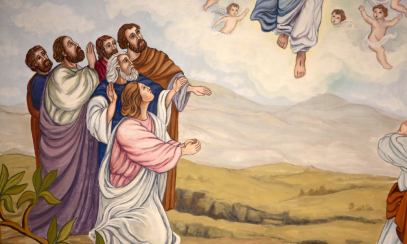
How Would You Explain Theology to a Teenager?
Cardinal Justin Rigali is the archbishop of Philadelphia. He serves on many committees at the Vatican, and attended the Second Vatican Council. We are honored to ask this eminent Catholic churchman and scholar some questions about the Catholic Church in the new millennium.
Q: How would you explain theology to a teenager?
A: Theology is the explanation of what we believe. And when we explain to a teenager, or anybody, what we believe, we start with the person we believe in: Jesus Christ. So we explain who he is: true God and true man. We explain that he is the second person of the blessed Trinity. The Father, out of love for us, sent his Son into the world and his son teaches us. Christ is close to us because he not only shares divinity with his Father, he shares humanity with his mother and with us. And so the explanation begins with Jesus, and his message of love, and with the crucifix. A great missionary, St. Francis Xavier, when he arrived in Asia, used the crucifix as a great instrument of explaining the faith, theology and what we are all about. He showed thousands of people the crucifix and told them, “This is Jesus. He loves us. This is the Son of God who came into the world. He shares his life with us. This is how we must live. This is what we must do. This is happiness.”
Q: Is there anything new we can learn about God?
A: Oh yes. Because God is infinite, and so loving, and so perfect, we will never be able to fathom or grasp him completely. And that is why, for 2,000 years, the church has been reflecting over and over again about God’s nature. While there are actually no new teachings of the church, there are developments of our own understanding of the beauty of what we know. For example, “true God and true man.” What does this mean? Well, the more we reflect, the more we grasp the inner meaning – the more we grasp the consequences, and the different aspects. It’s like looking at a diamond and there is a different perspective depending on the way you look at it. So, this is the richness of God’s life, which we can never exhaust completely. But it is always there for us to enter in through prayer to understand more deeply, more completely, more totally.
Are you a heretic?
A theology professor once remarked that there were no new heresies, just old ones repackaged. To test the truth of this statement, consider this recent real-life scenario and see if you can name the error involved:
What is wrong with books like The Secret?
Many of the books that top the bestseller list, especially in the area of spirituality, promise to deliver the keys to unlocking unimagined abundance and to awakening dormant, unrealized potential for each and every reader. These books employ titles like The Secret, Seven Keys to “Insert Theme Here”, and Ten Things the World (The Vatican, The Government, etc.) Does Not Want You to Know.
What is at stake? Objective revelation (completed in the Apostolic Age) and the church as the authority in interpreting the revealed Word of God
What is the truth? These books, as well as many movies, seek to take advantage of an almost subconscious Gnosticism that is ever present just below the surface in our society. They appeal to the Gnostic belief that salvation can be achieved through a “secret knowledge” available to a chosen few.
It, in fact, denies the church’s teaching that God’s objective revelation to humanity has already been completed because Gnosticism implies ongoing “secret” revelations that need to be discovered or unlocked. This approach to life also denies the claim that the truth of God’s objective revelation is universally accessible to all regardless of status, position, etc. Finally, it discards the Catholic understanding that the church is the ordinary means of salvation since it is God’s instrument of grace in the world. This understanding is undermined by a masked Pelagianism that suggests grace is not necessary for salvation – only secret knowledge is needed.
The church’s authority as the interpreter of the revealed Word of God is also nullified in this attitude. Interpretation and communication of the “secrets” of abundance and eternal life are left up to the individual and/or the privileged few.
Words of wisdom – can you complete the proverb?
The Sacred Scriptures teach us “to get wisdom, to get understanding!” (Proverbs 4:5) Now it is time to put yourself to the test to see how far along you are in this quest by completing this proverb. Remember, no peeking into your Bible!
Hate stirs up disputes, _______________________________
a. but the heart of the wicked is of little worth.
b. but the just one is established forever.
c. but love covers all offenses.
(Answer: c – Prov 10:12)
Church of Month
The power and vitality of the Christian faith have long inspired tremendous works of art on the part of believers. One has only to consider the beauty of many of our principal churches to realize the transcendent beauty of our faith. For example, consider:
Basilica of Our Lady of Guadalupe
The name Basilica of Guadalupe (also Basilica of Our Lady of Guadalupe, Basílica de Nuestra Señora de Guadalupe in Spanish) refers to one of the two churches built on top of Tepeyac hill, north of Mexico City. The site is near the place where Our Lady of Guadalupe appeared in front of Juan Diego Cuauhtlatoatzin.
The new basilica is considered the second most important sanctuary of Catholicism (this based upon the number of pilgrims it hosts per year), just after Vatican City. It houses the original tilma (or apron) of Juan Diego that shows the icon of Our Lady of Guadalupe. Thus it is an important pilgrimage site and is visited by several million people every year, especially around Dec. 12, the feast day of Our Lady of Guadalupe.
The basilica has seating for 10,000 inside the premises. However, temporary seats are often placed in the atrium that allow up to 40,000 people to take part in the Mass and other celebrations.
Origin:
The old basilica was known as the Templo Expiatorio a Cristo Rey and its construction began in 1531 – though it was not completed until 1709. The tilma of Juan Diego was housed in this church from 1709 to 1974 and survived a bomb planted by an anti-clerical activist in 1921.
The old basilica was sinking as a result of the weakness of the ground, because the city was built on a former lake, so a new, more spacious basilica was built. The old one was closed for many years and repairs have recently been finished. It is now again open to the public.
The modern basilica was built between 1974 and 1976 by the Mexican architect Pedro Ramírez Vásquez. It is a circular building constructed in such a way as to allow maximum visibility for the image to those inside. The structure is supported by 350 pylons that prevent the basilica from sinking with the rest of the ground.
Notable features:
• The tilma – The original tilma of Juan Diego upon which the image of Our Lady of Guadalupe appeared.



